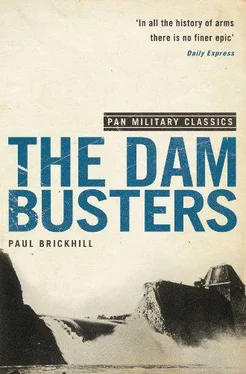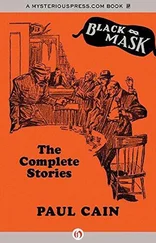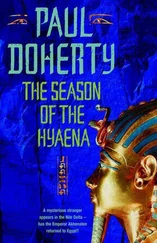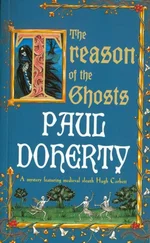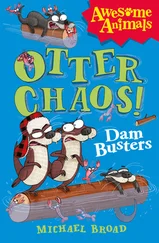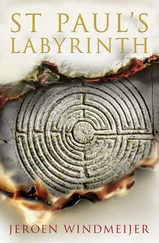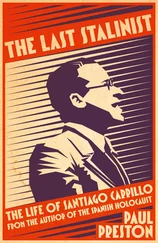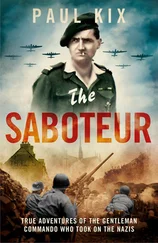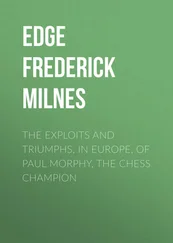“What squadron are you?” Satterly asked.
“What d’you mean, sir?”
“What number? You’ve got to have a number.”
“Oh,” said Gibson, “where d’you get that?”
“Somewhere in Air Ministry,” Satterly said, “but they probably don’t work so fast there. I’ll get on to them and fix it up. Meantime you’d better call yourselves ‘X Squadron’.”
* * *
Just before dinner on March 21, Wing Commander Guy Gibson, D.S.O., D.F.C., commander of “X”, the paper squadron, arrived at Scampton to take formal command. In the officers’ mess he found some of his crews already arrived and the mess waiters looking curiously at them as they stood around with pints of beer in their fists. It was obvious they were not to be an ordinary squadron; the average age was about twenty-two but they were clearly veterans. D.F.C. ribbons were everywhere; they had all done one tour, and some had done two. Gibson moved among them, followed by the faithful Nigger, his black Labrador dog, who rarely left his heels.
From his old 106 Squadron, Gibson had brought three crews as well as his own—those of Hopgood, Shannon and Burpee. Hopgood was English, fair and good looking except for a long front tooth that stuck out at an angle. Dave Shannon, D.F.C., was a baby-faced twenty-year-old from Australia, but did not look any more than sixteen, so he was growing a large moustache to look older.
Gibson spotted Micky Martin with satisfaction. They had met at Buckingham Palace when Gibson was getting his D.S.O. and the King was pinning on the first of Martin’s D.F.Cs. Though he came from Sydney, Martin was in the R.A.F., slight but good looking, with a wild glint in his eyes and a monstrous moustache that ended raggedly out by his ears. At the Palace they had talked shop and Martin had explained his low-flying system.
He had worked it out that if you flew lower than most bombers you would avoid the fighters; lower still and the heavy flak would all burst well above. And if you got right down to tree-top height you would be gone before the light flak could draw a bead on you. There was still the risk of balloons, but Martin reasoned there would not be any balloons along main roads or railways, so he followed those. He had had the same two gunners for two years. Toby Foxlee and Tammy Simpson both fellow-Australians, and on their low-level junkets they had become expert at picking off searchlights. Simpson and Foxlee had both come with him; he’d also brought an experienced navigator, a lean, long-chinned Australian called Jack Leggo, and his bomb aimer, Bob Hay, also Australian, had been a bombing expert at Group. Leggo was to be navigation officer of the new squadron, and Hay was to be bombing leader. It is unlikely that there was a finer crew in Bomber Command; hence Gibson’s pleasure.
He had chosen “Dinghy” Young as his senior flight commander. Young had already ditched twice in his two tours, and both times got back home in his rubber dinghy. Bred in California, educated at Cambridge, he was a large, calm man whose favourite trick was to swallow a pint of beer without drawing breath.
Les Munro was a New Zealander, tall, blue-chinned and solemn, a little older than the others. He was standing by the bar looking into space when Gibson located him. “Glad to see you, Les,” Gibson said. “I see you’re setting a good example already, drinking a little and thinking a lot.” Munro upended his pint and drained it. “No, sir,” he said, “thinking a little and drinking a lot.”
The other flight commander was Henry Maudslay, ex-50 Squadron, ex-Eton, an athlete, polished and quiet, not a heavy drinker. Towering above the rest was the blond head of a man who weighed nearly 15 stone, with a pink face and pale blue eyes; good looking in a rugged way. Joe McCarthy, from Brooklyn, U.S.A., former life-guard at Coney Island, had joined the R.A.F. before America came into the war.
No one knew what they were there for but, looking at the men around them, realised something special was in the wind. Someone finally asked Gibson what “the form” was and Gibson simply said: “I know less than you, old boy, but I’ll see you all in the morning to give you what gen I can.”
In the morning Gibson called all the crews to the long briefing room on top of station headquarters and said:
“I know you’re wondering why you’re here. Well, you’re here as a crack squadron to do a special job which I’m told will have startling results and may shorten the war. I can’t tell you what the target is or where it is. All I can tell you is you’ll have to practise low flying day and night until you can do it with your eyes shut….”
He went on to talk about training and organisation, and when it was over the crews trooped out with little flutters in their stomachs, the sort of feeling you get before a raid. It goes once you get into the air.
Dinghy Young and Maudslay were busy dividing the crews into flights and Gibson walked over to No. 2 hangar, the great steel shed that was to be squadron headquarters. Inside, a dapper little man with a toothbrush moustache broke off his interviewing and saluted smartly; Flight Sergeant “Chiefy” Powell had just arrived to be the squadron’s disciplinary N.C.O. The ground crews were arriving in scores and Powell already had half of them organised in their billets and sections.
Cochrane rang Gibson: “I’m sending you over a list of lakes in England and Wales that I want photographed. Get someone on to it as soon as you can.”
Gibson, who had learned not to ask questions, said, “Yes, sir,” wondering when the fog of secrecy was going to lift.
Gibson spent hours interviewing his aircrews, sizing up the ones he didn’t know, and found that some of the squadron commanders, told to send their best men, had played the age-old service game and got rid of a couple they did not want. Gibson told them to pack and go back. He walked into the mess bar just before dinner, tired but feeling they were getting somewhere, and Charles Whitworth buttonholed him.
“Well, Gibby,” he said, “you’re going to command 617 Squadron now.”
The little man looked thunderstruck. “What! “he exploded. “617? I thought… I… Who and where are they ? “
“Here,” said Whitworth peaceably. “You. Your new number. Someone in Air House has moved off his bottom. Your Squadron marking letters are AJ.”
He called for a pint each and they drank to 617 Squadron.
CHAPTER V
OVER THE HURDLES
HUMPHRIES, the new adjutant, arrived next afternoon; a little fair-haired man, only twenty-eight, he was keen on flying but his eyes had stopped him. Gibson told Humphries as much as he knew himself, and as Humphries was leaving his office Gibson said:
“I don’t know yet what it’s all about, but I gather this squadron will either make history or be wiped out.”
In the morning the curtain lifted a little. Gibson got a call from Satterly, who told him to catch a certain train to Wey-bridge, where he would be met at the station.
“May I know who I’m meeting, sir?”
“He’ll know you,” Satterly said.
Gibson walked out of Weybridge Station at half-past two and a big man squeezed behind the wheel of a tiny Fiat said, “Hello, Guy!”
“Mutt,” Gibson said, surprised. “Are you the man I’m looking for?”
“If you’re the man I’m waiting for, I am,” Summers said. “Jump in.” They drove down the winding tree-lined road that leads to Vickers and went past the main gates without turning in. “What’s this all about, Mutt?” Gibson said, unable to hold back any longer.
“You’ll find out.” He turned off up a side road to the left. “You wanted to be a test pilot for me once. D’you remember? “
Читать дальше
